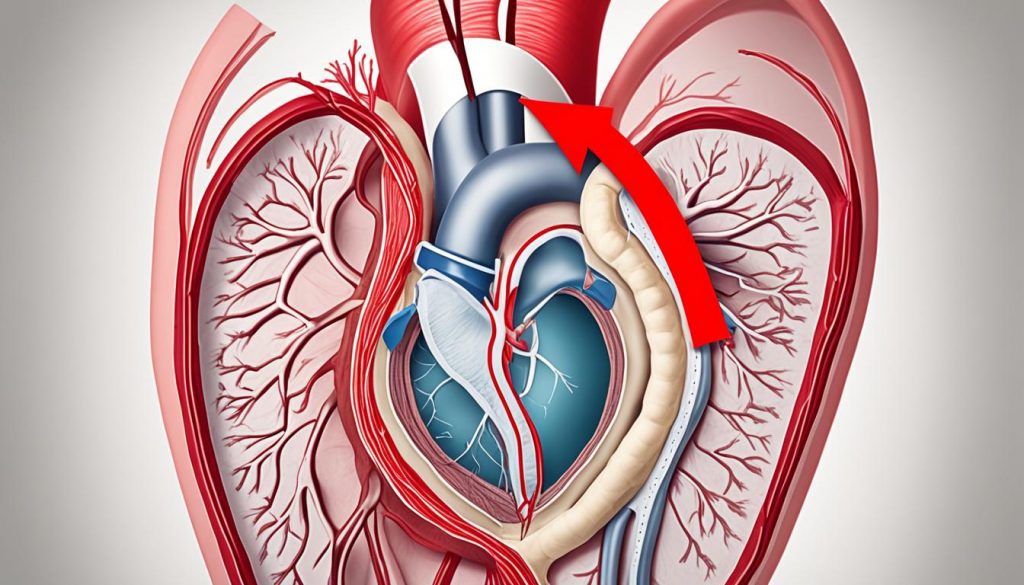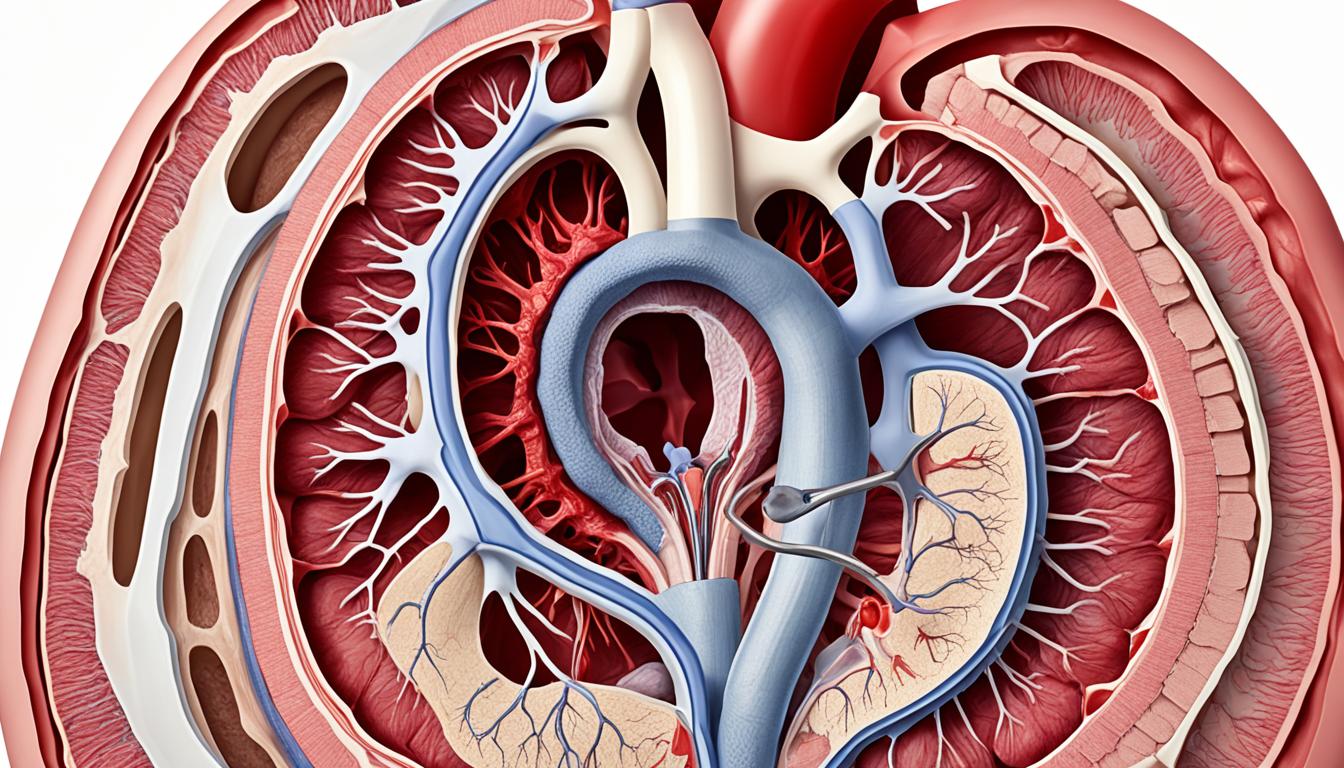Heart health is really important. Bicuspid aortic valve disease is a key concern. It’s a birth defect where the aortic valve is off. Unlike normal hearts with three leaflets, this condition means only two leaflets are present. This can cause serious issues.
About 1 to 2 percent of people have this condition, and it’s more common in men. It can go unnoticed for a long time. Often, it doesn’t show symptoms until it gets worse. Catching it early and managing it is crucial to avoid serious problems, like needing valve surgery.
This article talks about the signs, reasons, and ways to figure out if you have bicuspid aortic valve disease. We will also discuss stem cell therapy as a new treatment. Knowing about this condition and how to treat it helps keep your heart healthy.
Causes of Bicuspid Aortic Valve Disease
Bicuspid aortic valve disease is a heart defect present at birth. It affects the aortic valve, causing genetic issues and structural problems. Though its exact cause is not known, it’s thought to form during fetal growth. This condition often runs in families.
The disease is linked to genetic problems that can be passed down through families. However, not all family members will get it. Knowing your family health history is key. It helps in spotting risks for genetic issues and disease development.
Sometimes, the disease may skip generations. This means even distant relatives should know their family health history. Recognizing genetic patterns helps catch the disease early. Early detection means better management and treatment choices.
There’s no way to prevent bicuspid aortic valve disease right now. But, genetic counseling and heart checks can be very useful. They help those with family history understand their risks. This helps them make better health choices.
Diagnosis of Bicuspid Aortic Valve Disease
Doctors can spot bicuspid aortic valve disease through exams and tests. At the exam, the doctor listens for a heart murmur. This unusual sound happens as blood flows through the bicuspid valve.
Yet, hearing a murmur doesn’t confirm the disease. To know for sure, doctors use an echocardiogram. This safe test uses sound to make heart images. It shows the aortic valve’s shape and how well it works.
Sometimes, people don’t know they have this condition until symptoms show up. They might feel short of breath, have chest pain, or feel very tired. These signs mean there could be a heart issue. So, it’s key to get help if they appear.
After a diagnosis, keeping an eye on the disease is key. Patients should see their heart doctor regularly. The visits help watch the valve and spot any problems early. This way, doctors can act fast if things change.
Treatment Plan
The treatment for this heart valve disease depends on how severe it is and if there are other health issues. Some people might not need treatment right away. This is if their valve works fine and they’re feeling OK.
But if the valve gets worse or symptoms get bad, doctors will need to step in. Options include medicines, valve repair, or even putting in a new valve. The choice depends on how bad the valve’s condition is.
When the disease causes the valve to narrow or leak, surgery is often suggested. Surgeons might fix the valve or replace it. The decision between a mechanical or a tissue valve is made with the heart doctor.
It’s vital for patients to team up with their doctors to make a care plan. Following the plan and staying active can help them live better. They should also exercise and live healthily.

Risks and Treatment of Bicuspid Aortic Valve Disease
Bicuspid aortic valve disease might lead to serious issues that need quick care and treatment. Two common risks are aortic valve stenosis and aortic valve insufficiency. Aortic valve stenosis happens when the valve’s two leaflets narrow from calcium buildup. This narrowing limits blood flow, making the heart work harder.
Aortic valve insufficiency, in contrast, occurs when the valve’s leaflets don’t close right. This lets blood leak back into the heart. The backflow puts extra strain on the heart. It can cause symptoms like shortness of breath, fatigue, and chest pain.
Another risk with bicuspid aortic valve disease is a thoracic aortic aneurysm. This refers to the enlargement of the aorta, the body’s largest artery. It can lead to serious problems like aortic dissection and dangerous ruptures.
It’s key to treat these risks quickly and effectively. Treatment depends on how severe the condition and its complications are. Some people might only need medication and lifestyle changes. These can help manage symptoms and slow the disease’s progress.
Yet, severe cases might require surgery, like valve repair or replacement. Valve repair fixes the patient’s natural valve by addressing issues like calcium deposits. But valve replacement involves swapping the flawed valve for a prosthetic one, either mechanical or biological. The decision on surgery considers the patient’s age and health.
Surgical advancements have made valve repair and replacement safer and more effective. They now have shorter recovery times and better results. However, surgery doesn’t cure bicuspid aortic valve disease. Ongoing appointments and monitoring are vital. They help track the valve’s function and the patient’s heart health overall.
img src=”https://seowriting.ai/32_6.png” alt=”Valve Replacement Surgery” align=”middle”
Stem Cell Therapy for Bicuspid Aortic Valve Disease
Stem cell therapy is a new way to treat heart problems like bicuspid aortic valve disease. Most studies so far have looked at heart disease caused by blocked arteries. But now, scientists are also focusing on fixing heart issues people are born with using stem cells. They want to make living tissue that can grow with the patient’s heart.
This new method could be better and last longer than current surgeries. Traditional surgeries often need to be done more than once. But with stem cells, doctors aim to fix the heart in a way that lasts. They want the new tissue to blend in and help the heart heal itself.
Regenerative medicine brings new hope to those with bicuspid aortic valve disease and other heart problems. With ongoing research, there’s potential for better treatments. This could mean a better life for patients, not just in Thailand but everywhere.

